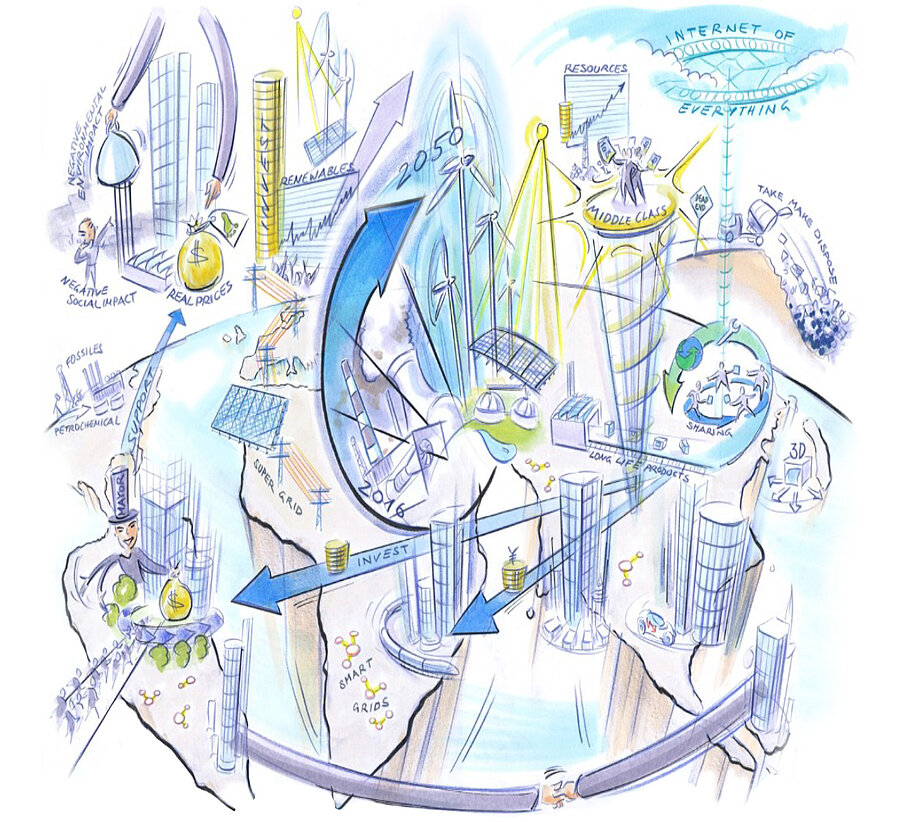Is there a place for filtration in 2050?
Or: How megatrends could change the world of filtration solutions
It is impossible to imagine our lives without filters. There are a huge number of applications, ranging from commodity products such as cabin air filters and water purifiers to solutions for highly critical applications and hazardous areas.
The sector has an annual turnover of more than 70 billion US dollars. There has been no significant change in the products and fields of application in recent decades. Although filtration solutions are becoming more powerful and even more precisely adapted to their respective applications, disruptive developments have not yet affected the industry. So what will the future look like? Which trends will have the biggest impact on the development of the sector?

Global population: 10 billion people (70 percent of whom live in cities)
Asia, Africa, and Latin America driving economic growth
Phasing-out of fossil fuels almost complete
Economy and everyday life fundamentally shaped by the concept of sustainability
How megatrends influence the filter business
Megatrends are general long-term developments that influence society, the economy, and individuals on a private basis.
They are a model for change in the world and influence both our direct actions and global economic contexts.
Mobility, decarbonization, liveability and digitalization are the megatrends with the greatest impact on the demand for filtration solutions and on the industry itself.
| Mobility |
Filters phased out for new mobility while demand rises in other applications
The proportion of electrically and alternatively powered vehicles will increase sharply in the future. While vehicles with internal combustion engines require more than 30 filter elements, the car of the future will need no more than a handful of filters. As battery electric vehicles do not require any intake air or liquid filtration, competition will continue to increase and there will be further market consolidation. New concepts such as car sharing and autonomous-driving mobility services will increase the need for more efficient cabin air filters. Demand for customizable, digitally adaptable filtration concepts will also grow and lead to innovations.
Mega trend mobility
Development of global vehicle stock and type of drive until 2050
| Decarbonization |
Mega trend “Decarbonization”
Change of global primary energy consumption by energy source
Emissions will fall, but air pollution control requirements will be higher than ever
While many political institutions are aiming to combat global warming by becoming CO2-neutral by 2050, in many industries, there is increasing momentum to achieve far more ambitious targets. Rising costs due to emissions (e.g. via CO2-certificates) are another reason for stakeholders to act. Energy-efficient filtration solutions can be part of the solution, as 10-20 percent of energy in industry and commerce is currently used for air filtration. Filters actively contribute towards reducing emissions. Strict air pollution regulations will increase the need for filtration concepts in the future. That being said, demand for filters in the power generation sector will slowly but surely decrease. Power plants that run on renewable energies (with the exception of green hydrogen) require significantly fewer filter elements than those that run on fossil fuels.
| Liveability |
Awareness of clean air is on the rise and is being further fueled by urban growth
The way people live and want to live has a significant impact on the sector. Smog, the Coronavirus, and other factors have already raised awareness of how important health and clean air are. This trend could intensify in the future. Projections reveal that the risk from fine dust will continue to increase, especially in urban areas. Fortunately, other problems (e.g. access to clean drinking water and sanitation) will decline over the same period. Health emergencies such as the Coronavirus pandemic and other health-related issues will have a huge impact on the market. There will also be a greater focus on customizable, high-end filtration solutions for the home. This means that filter manufacturers must in future be agile if they are to respond quickly and flexibly to market requirements.
Mega trend “Liveability”
Pollutants will continue to shorten life’s
| Digitalization |
Mega trend “Digitalization”
Digitalization enables and requires new business models
The omnipresent buzzword with potential for disruption
Digitalization already exerts an influence on the market. Increasing data transparency and comparability is leading to greater competitive pressure, which means that only high-quality filtration products will prevail in the future. On the user side, data-driven, condition-based filter management is leading to greater efficiency and fewer filter changes overall. Real-time data and digital monitoring solutions are helping to minimize damage to electronic infrastructure such as data centers. This can prevent corrosion-related failures caused by contaminant gases. The service landscape is also changing. In 2050, software with machine learning algorithms and extensive plant data will support and optimize services on an individual basis.
The new normal: customized solutions
One megatrend shapes every other:
individualization. Products, whether they be in the automotive, industrial, or living sector, will increasingly adapt to individual needs and requirements.
The need for high-performance filtration solutions will also increase. Population growth and increases in health awareness are steadily driving this development. For us, this means being open to change and steering a path toward becoming an agile, flexible, climate-friendly partner. It also means continuing to cooperate closely in order to translate the challenges we encounter in our daily work and the requirements of our customers into beneficial products.
 automotive filtration insight
automotive filtration insight